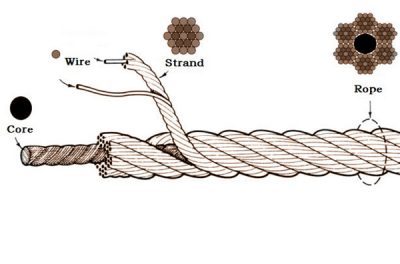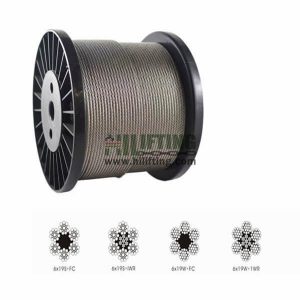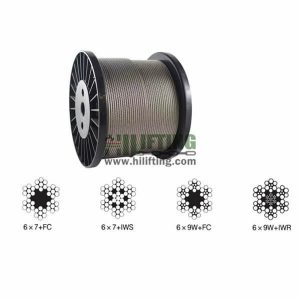Do You Really Know Wire Rope? – Wire Rope Basics For You
1. What Is Wire Rope?
Wire rope can be seen everywhere around us, it is made of strands or bundles of individual wires constructed around an independent core, suitable for hoisting, towing, and anchoring heavy loads.
2. Wire Rope Construction
Wire rope is specified by the number of strands in the rope, the number of wires in each strand, and the strands are then twisted to form a rope construction.

2.1 Wire
Wires are the main component of wire rope and they are twisted together around a central wire to form strands.
2.2 Wire Rope Strand
The strand is made up at least two wires twisted in a specific arrangement, then the strands are helically laid together around a core of the rope.
2.3 Wire Rope Core
The wire rope core is in the center of the rope and provide the rope stability, it is the foundation for the wire rope. Cores can be supplied with natural or synthetic fibers and steel core. For example, the 6×19 FC wire rope means that the rope has 6 strands, and there are 19 wires in each strand, the numbers 6×19 is followed by a letter combination, it means the core of the wire rope, FC means fiber core.
Fiber core= FC, PC or HC
Fiber cores are made of natural material, such as sisal, or hemp core wire rope(HC) or a synthetic fiber such as polypropylene core wire rope(PC).
Steel core= IWRC(Independent wire rope core) and WSC(wire strand core)
IWRC is commonly manufactured from 7 strands, while the WSC is manufactured from either 7 or 9 wires. Steel cores have a higher resistance to drum crushing and where less stretch and more strength is required.
2.4 Different Wire Rope Constructions
The 6×19 FC wire rope means that the rope has 6 strands, and there are 19 wires in each strand, however, 6 x 19 wire rope may not reflect the actual construction, for 6 x 21 wire rope, and 6 x 26 are designated as being in the 6 x 19 classification, despite none of their constructions contain 19 wires.
Here below is the table to show some of the most common wire rope configurations arranged in specific classifications.
| Classification | Outer Strands | Wires/Strand |
| 6×7 | 6 | 3-14 |
| 6×19 | 6 | 15-26 |
| 6×37 | 6 | 27-49 |
| 6×61 | 6 | 50-74 |
| 6×91 | 6 | 75-109 |
| 7×19 | 7 | 15-26 |
| 7×37 | 7 | 27-49 |
| 8×7 | 8 | 3-14 |
| 8×19 | 8 | 15-26 |
| 8×37 | 8 | 27-49 |
| 8×61 | 8 | 50-74 |
3. Wire Rope Grades
There are many different wire rope grades, the higher grade, the higher min breaking strength, commonly the grades of wire rope are available include Improved Plow Steel (IPS), Extra Improved Plow Steel (EIPS), Extra Extra Improved Plow Steel (EEIPS), and metric wire rope grades can be designated as 1770n/mm²(Improved Plow Steel), 1960n/mm²(Extra Improved Plow Steel) and 2160n/mm²(Extra Extra Improved Plow Steel).
4. Finish
There are main three protective coatings on the wire rope, zinc-coated (galvanized) wire rope for harsh environment, uncoated steel (bright) wire rope for most running supplied, and stainless steel wire rope for marine and architectural applications.
5. Type And Direction Of Lay Wire Rope
The type and direction of lay wire rope mean the wires are laid around the strands(regular lay or lang lay) and the direction in which the strands are laid around the core(a right or left hand).

5.1 Regular lay
Regular lay is also referred to as ordinary lay. The strands are twisted in one direction, either left or right across the core and the wires are laid in opposite direction to the lay of the strands, which causes the finished product to appear like the wires are running parallel to the axis of the rope.
The regular lay wire rope is more flexible and carries better resistance to crushing forces and is more naturally rotation-resistant and spool better on a drum than lang lay wire rope.
5.2 Lang lay
The lang lay wire rope indicates that the wire lay and strand lay around the core in the same direction, either right or left and causes the finished product to appear with the wires to form an angle with the axis of the rope. Thes lang lay ropes are generally more flexible and have increased abrasion resistance leading to a longer lifespan than regular lay ropes, which can be used in construction, excavating, and mining applications.
If you’re looking for more wire rope basics, contact our Specialist via info@hilifting.com, our knowledgeable sales team is always happy to help.






